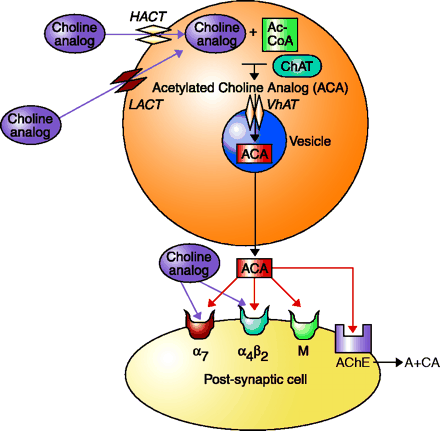
- Institution: Stanford Univ Med Ctr Lane Med Lib/Periodical Dept/Rm L109
- Sign In as Member / Individual
Neuronal Nicotinic Receptor Subtypes: DEFINING THERAPEUTIC TARGETS

Representation of the cholinergic synapse. The potential sites of action for novel analogs of choline are indicated. The choline analog may be transported into the cell by the high-affinity (HACT) or low-affinity (LACT) choline transporters, so that the drug could compete with endogenous choline for acetylation by acetylcoenzyme-A (Ac-CoA) and the synthetic enzyme choline acetyltransferase (ChAT). The acetylated choline analog (ACA) would then be transported into the cholinergic synaptic vesicle by the vesicular acetylcholine transporter (VhAT). Cell depolarization resulting from neural activity would cause the vesicular release of the ACA (i.e., a “false neurotransmitter”). Within the synapse, the ACA could interact with nicotinic or muscarinic (M) receptors. The ACA also could interact with soluble or membrane-bound acetylcholinesterase (AChE), the enzyme that normally degrades ACh. If the ACA either inhibits AChE or is a poor substrate for hydrolysis by AChE, synaptic efficiency would be increased. Alternatively, the choline analog could directly activate nicotinic receptors, particularly the α7 subtype.


